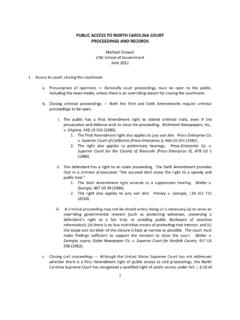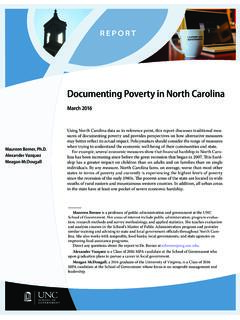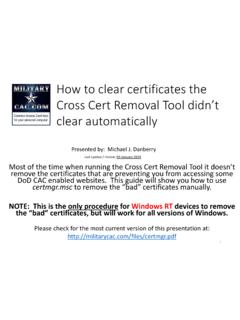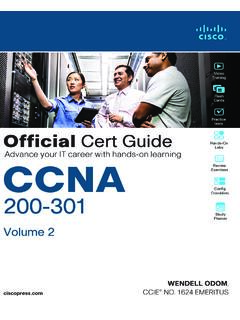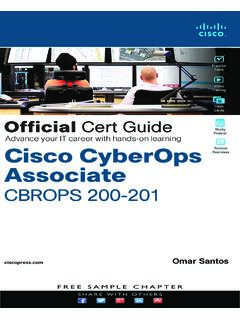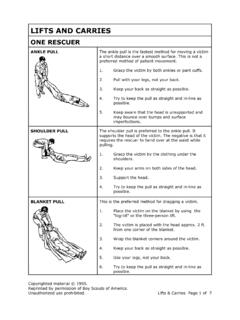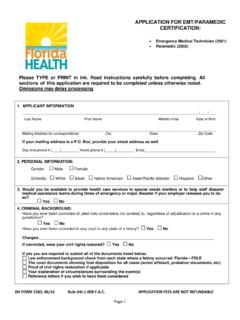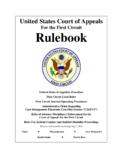Transcription of CHARACTER EVIDENCE QUICK REFERENCE
1 CHARACTER EVIDENCE QUICK REFERENCE . reputation opinion specific instances of conduct - habit CHARACTER of the Defendant 404(a)(1) (pages 14-29). (pages 4-8). * Test: Proper Purpose + Relevance + Time * Test: Relevance (to the crime charged) + Similarity + 403 balancing; rule of inclusion + 403 balancing; rule of exclusion * Put basis for ruling in record (including * Defendant gets to go first w/ "good 403 balancing analysis). CHARACTER " EVIDENCE . reputation or opinion only (see rule 405) * D has burden to keep 404(b) EVIDENCE out ^ State can cross -examine as to specific instances of bad CHARACTER * proper purposes: motive, opportunity, knowledge/intent, , common * Law-abidingness ALWAYS relevant scheme/plan, identity, absence of mistake/.
2 Accident/entrapment, res gestae (anything * General good CHARACTER not relevant but propensity). * Defendant's CHARACTER is substantive ^ Credibility is never proper 608(b), not 404(b). EVIDENCE of innocence entitled to instruction if requested * time: remoteness is less significant when used to show intent, motive, , * D's EVIDENCE of self-defense does not knowledge, or lack of mistake/accident - automatically put CHARACTER at issue * remoteness more significant when common scheme or plan (seven year rule). ^ unless continuous course of conduct, or D is gone * similarity: particularized, but not CHARACTER of the victim 404(a)(2).
3 (pages 8-11). necessarily bizarre ^ the more similar acts are, the less problematic time is * Test: Relevance (to the crime charged). + 403 balancing; rule of exclusion * convictions generally not 404(b) admissible ^ unless used for motive for assault, malice in DWI. murder cases, or statute-based * Defendant gets to go first w/ "bad CHARACTER " EVIDENCE : reputation or opinion only (see rule 405) Habit 406. (pages 12-14). ^ State can cross -examine as to specific instances of good CHARACTER Test: Relevance (to the crime charged). + 403 balancing * Victim's violent disposition is relevant in self-defense cases to * Used to prove conformity of conduct (1) whether Defendant's fear was * Can be opinion or specific instances reasonable (D has to know about it) * Factors: (1) similarity of conduct.
4 ^ not a 404 issue goes to D's state of mind (2) number of times; (3) regularity of ^ V's criminal record can be admissible here conduct; (4) reliability of EVIDENCE if relevant to D's state of mind * Habit of doing something (admissible) vs. (2) whether victim was the aggressor habit of being something (usually not). (D doesn't have to know about it). ^ if D doesn't know about it, EVIDENCE is * Harder to prove habit of inaction (not doing carefully limited to close cases something) vs. habit of action ^ V's criminal record not relevant here Other acts 404(b). CHARACTER AND HABIT EVIDENCE . Rules 404, 405, and 406. Ripley Rand Special Superior Court Judge Advanced Criminal EVIDENCE May 2010.
5 A. Generally Speaking The general rule: CHARACTER EVIDENCE IS NOT ADMISSIBLE. More particularly, CHARACTER EVIDENCE is generally not admissible when offered for the purposes of proving conduct in conformity with the CHARACTER trait offered. CHARACTER is the actual qualities of an individual; reputation is that person's standing in the community as viewed by other people. (As noted in State v. Ussery, 118 1177 (1896), CHARACTER is inside a person; reputation is outside a person.) Because of this distinction, courts typically limit the use of CHARACTER EVIDENCE it is not directly relevant to the charges at hand (except in very limited instances), and there is a danger that the jury will misuse it.
6 B. Use of CHARACTER EVIDENCE (1) Proof of CHARACTER can be made in four ways: Rule 404: Reputation*. Opinion Specific Instances of Conduct Rule 405: Mechanics of how CHARACTER EVIDENCE works Rule 406: Habit * Reputation EVIDENCE (with associates, or in the community) is a hearsay exception set out in Rule 803(21). (2) Standard of Proof for CHARACTER EVIDENCE : Preponderance of the EVIDENCE (3) Rule 405 circumstantial use of CHARACTER EVIDENCE : Where CHARACTER trait is admissible, proof on direct examination may be made by testimony involving reputation or opinion testimony (circumstantial use of CHARACTER EVIDENCE ). cross -examination of witness who gives reputation or opinion EVIDENCE can be made on relevant specific instances of conduct (relevant to the CHARACTER trait at issue).
7 2. * cross -examiner has to have good faith basis for specific instance EVIDENCE . State v. Flannigan, 78 App. 629 (1985), cert . denied, 316. 197 (1986). * Party seeking to admit reputation or opinion testimony has to lay appropriate foundation; you need more foundation as to reputation (based on familiarity with reputation in the community, etc.) than opinion (based on personal dealings). State v. Morrison, 84 App. 41, cert . denied, 319 408 (1987). * There is no time limit on specific instances cross -examination after Defendant puts on EVIDENCE of good CHARACTER . State v. Cummings, 332. 487 (1992). See also State v. Hargett, 157 App.
8 90 (2003). (thirty-year old conviction OK); State v. Rhue, 150 App. 280 (2002), cert . denied, 356 689 (2003) (twenty-year old conviction OK). * Where charged with murder of child, Defendant can't offer specific instances where he did not abuse other children; reputation and opinion only. State v. Murphy, 172 App. 734 (2004), vacated in part on other grounds and remanded, 361 264 (2006). * CHARACTER EVIDENCE can also be used to respond to EVIDENCE presented by the other side. * CHARACTER EVIDENCE about defendant's reverence for mother and refusal to swear on her grave allowed where State elicited EVIDENCE that Defendant refused to swear on mother's grave that he was innocent.
9 State v. Powell, 340 674 (1995), cert . denied, 516. 1060 (1996). * CHARACTER EVIDENCE about victim's generally appropriate disposition and being a perfect gentleman allowed where Defendant elicited EVIDENCE that victim suffered from dementia and was dangerous to himself. State v. Jennings, 333 579 (1993), cert . denied, 510 1028 (1993). * CHARACTER EVIDENCE that victim was a good nephew and worked hard allowed where Defendant offered EVIDENCE that victim was a gang member. State v. Taylor, 344 31 (1996). * CHARACTER EVIDENCE that Defendant was a gang member allowed where Defendant had put on CHARACTER EVIDENCE of being a good Marine.
10 State v. Perez, 182 App. 294 (2007), cert . denied, 362 248 (2008). 3. * be careful about mere EVIDENCE of gang membership, though (as opposed to gang-related activity) EVIDENCE of gang membership must be relevant, as individual has a First Amendment right to association in a gang. Dawson v. Delaware, 503 159 (1992), cert . denied, 519 844. (1996). See also State v. Gayton, 185 App. 122 (2007). (admission of EVIDENCE about gang membership was error when it was not relevant to drug trafficking charge at issue);. State v. Hope, ___ App. ___, 657 909 (March 18, 2008) (admission of EVIDENCE about gang membership error when not relevant to murder charge).


